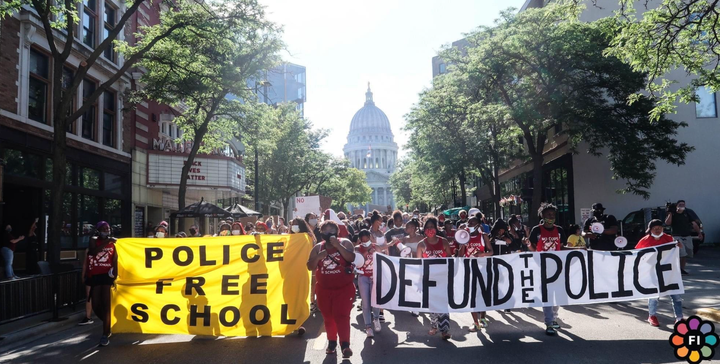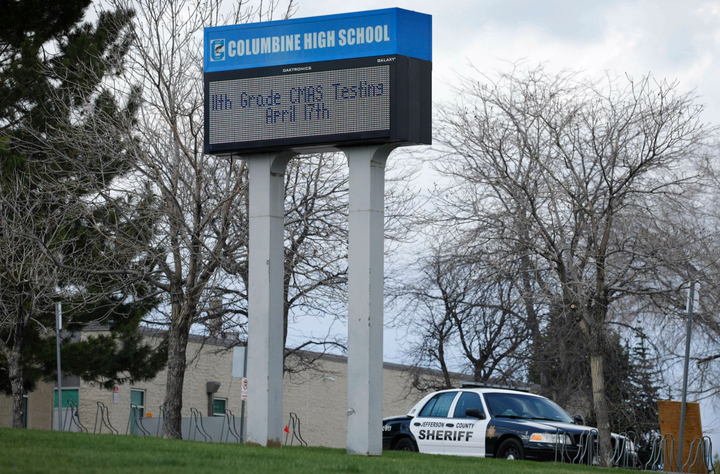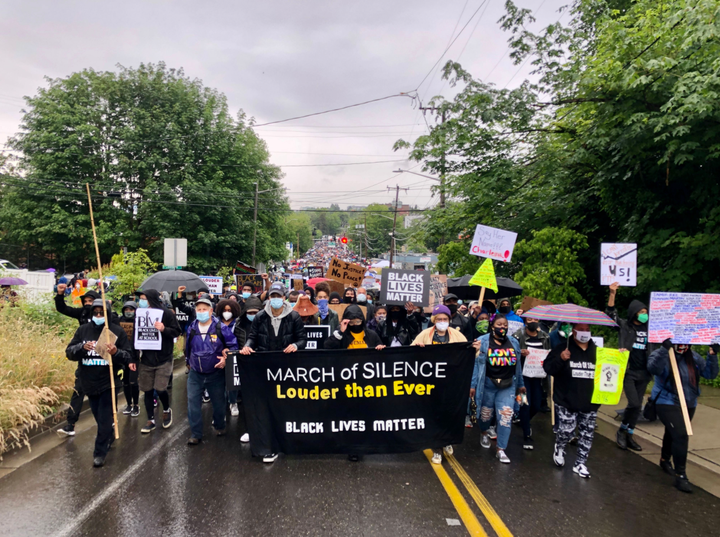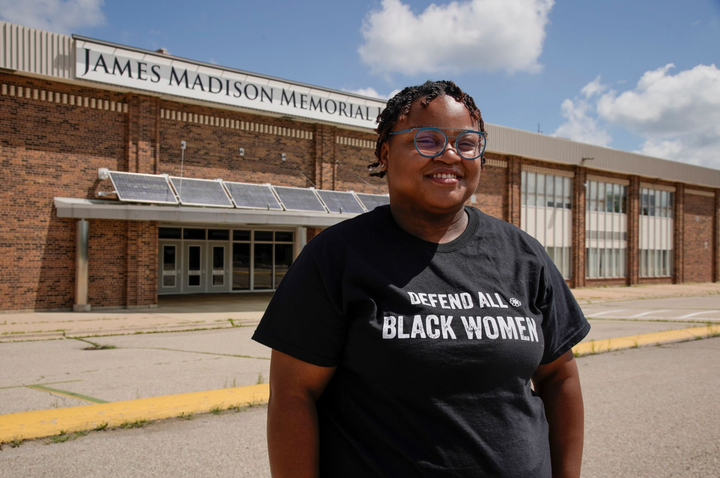
Shyra Adams vividly remembers the days after the death of Tony Robinson, an unarmed Black teenager killed in 2015 by police in her hometown of Madison, Wisconsin.
Angry and distraught over the injustice, Adams, then a high school sophomore, staged a walkout with hundreds of other students, who filled the state Capitol to protest Robinson’s death. She joined weekly protests and helped organize sit-ins at her school. Then, she cried quietly in class as she watched the Dane County district attorney announce on TV that no charges would be filed against the officer who shot and killed Robinson.
“It felt kind of hopeless at that point,” Adams, now 21, said.
But this summer, after five years of testifying at nearly every Madison school board meeting about the importance of removing police from schools, Adams found herself crying for a different reason. This time, she said, the tears came from her renewed hope that fighting for young people of color could lead to change. In June, she and other members of the Freedom Youth Squad, a group of Black and Southeast Asian activists, gathered to watch the Madison school board’s unanimous vote to cancel its contract with municipal police and remove all officers stationed at its high schools.
“A lot of people in different states were winning, but I thought, ‘In Madison? No way. They’ve been ignoring us for years,’” Adams said. “But that’s changing now. We finally got the votes.”
Across the U.S., the death of George Floyd in police custody in May rekindled long-simmering debates over the role of school resource officers, as on-campus police are often called. Subsequent protests convinced dozens of school boards across the country to formally sever ties with local law enforcement, defund their internal police departments, or remove or reduce the presence of officers in schools. Big cities like Denver and Minneapolis, where Floyd died, have cut ties with police, as have school boards in smaller cities like Spokane, Washington; Ypsilanti, Michigan; and Salem, Massachusetts.
But even as activists like Adams celebrate these recent wins, many also now wonder: Once police physically leave a school, what’s to stop teachers and principals from calling 911 to get them back?
Recent research has tied the presence of police in schools to an uptick in student discipline, especially for children of color, and a decrease in graduation and college enrollment rates. And over the past few decades, educators have relied more and more on police to handle routine student discipline, with schools referring hundreds of thousands of students to law enforcement each year. But depending instead on officers outside the school system — who often have minimal training in how to work with children — may not end the overly harsh school discipline that activists have targeted.
This new dilemma has prompted some recognition among educators and policymakers that it will take more than changing schools’ relationships with police to rebuild trust with community and students. And to avoid falling back on calling 911 as the default, teachers and students alike have called for renewed investments in other adults — like social workers and mental health counselors — that allow everyone on campus to feel safe.
“Yes, we eliminated the police department,” said Jasmine Williams, communications director for the Black Organizing Project, which led the fight to remove police from schools in Oakland, California. “But these [school] staff members, these teachers will still be calling the police on our Black students.”

Related: Protecting or policing?
In 2011, following the death of 20-year-old Raheim Brown at the hands of school police officers, Black community organizers in Oakland pledged to eliminate the school district’s police department. But it wasn’t until student-led March for Our Lives demonstrations this summer that the Oakland school board unanimously passed a resolution in June to disband its police department within six months.
Since the 2015-16 school year, teachers and staff at Oakland schools called the police more than 9,000 times, according to data included in the new resolution. Three out of four arrests made were of Black students, despite their representing just a quarter of overall enrollment in the district.
Black organizers in Oakland have anticipated that calls to 911 could become the default once the school district dissolves its police department by the end of this year. To head that off, they began asking teachers to sign a “Black Sanctuary Pledge” in 2018. So far, according to the Black Organizing Project, more than 300 out of 3,000 teachers union members have pledged not to call police on children for disciplinary issues, including school fights.
“We can’t demonize the people working with our students,” Williams said. “But we can hold them accountable.”
According to the most recent data available, teachers and school staff send thousands of classrooms’ worth of students to the police each school year. In 2017-18, school districts reported referring at least 221,000 students to law enforcement, with nearly two-thirds of those referrals for students of color. At least 51,000 of those incidents resulted in an arrest, according to a Hechinger Report analysis of federal data compiled by the Office for Civil Rights at the U.S. Department of Education.
And that’s almost certainly an undercount, said Dan Losen, director of the Center for Civil Rights Remedies at the University of California, Los Angeles, which focuses its research on the school-to-prison pipeline and racial inequity in special education.

Both Losen’s detailed analysis of federal data on student referral and arrest rates in 2015-16 and a quick Hechinger analysis of the corresponding numbers in 2017-18 show that data collection for some large districts was either incomplete or entirely absent. New York City, for example, which enrolls more than a million students, appears to have zero school-based arrests, which can’t be true, Losen said. The Every Student Succeeds Act, passed in 2015, requires states to report school-policing data, but, according to Losen’s research, not one state had met that obligation by July 2020.
Related: No longer ruled out: an educator develops strategies to keep court-involved students in school
Regardless of the missing or incomplete data, local news headlines make clear that police are frequently called to schools.
In Seattle, a white teacher called 911, saying a Black fifth grade boy threatened to beat her up, The Seattle Times reported in 2019. She didn’t press charges.
In Texas’ Round Rock Independent School District, an assistant high school principal called the police on three students for taking animal crackers and pretzels from a teachers lounge in 2018, according to local media reports. An officer investigated and charged each student with theft.
Tiffanie Harrison, a teacher in the district, refers to the incident as “Animal Cracker Gate.” And it — along with video footage from 2015 of a police officer grabbing a student by the throat in a nearby high school — helped convince her to run for the school board. She won a seat this November, and plans to question why the school district chose this year to start a new police department at the cost of $1.7 million.
“Quite frankly, we don’t need police in schools,” Harrison said. “We can call if we have an emergency.”
Jeffrey Yarbrough, the first chief of police there, said he’s encountered educators who ask officers to issue citations for infractions he wishes they would handle on their own, like disrupting a class, talking too loudly or wearing too much perfume.
“That’s insane to me,” Yarbrough said. “There shouldn’t be laws on the books that allow officers to write citations for immaturity.”
Still, he argues that having one law enforcement agency focused on dealing with kids and hiring specially trained school-based officers will be better than leaving to chance who shows up when teachers or school staff call 911.
“Even if you don’t have law enforcement on your campus, you’re going to have to have a law enforcement presence to deal with certain offenses,” he said. Without on-campus police, “who’s coming and how they will respond to juveniles is a crapshoot every time.”

Los Angeles — now home to the nation’s largest independent school police force — first assigned officers to patrol schools in 1948 as civil rights leaders dismantled formal segregation in neighborhoods and schools. About a decade later, Oakland followed suit for similar reasons: Black Southerners were moving to the city, and under pressure to desegregate schools, the district created its internal police department in 1957.
Other districts followed suit. By the early 1970s, often amid racial anxieties, urban school districts in 40 states had some form of police within their schools, according to the American Civil Liberties Union.
“As a result, youth of color were policed in neighborhoods, in bodegas, in housing project stairwells and now, in classrooms,” the ACLU wrote in a 2017 report.
In recent decades, several high-profile mass shootings, including the Columbine High School massacre in Colorado in 1999, have fueled national attention to school safety and increased interest in policing on campus. Federal grants, such as the “COPS in Schools” program, helped place thousands of officers in schools, with the number of school resource officers topping 46,000 in 2007-08. As of 2017-18, just about half of all public schools in the U.S. reported having at least one sworn law enforcement officer on campus.
Related: Almost two decades after Columbine, how to prevent school shootings still vexes security experts
And once police officers are in the building, teachers and principals start to rely on them to handle misbehavior, not just violence, said Emily Mooney, a policy fellow with the R Street Institute, a think tank in Washington, D.C.
School police “are often increasingly serving that role as school disciplinarian,” she said. “That’s not the role they were trained to do. It is too much to ask … and certainly can conflict with their ultimate mandate of enforcing the law.”
In a white paper she co-authored this year, Mooney cited research that connected officers hired through the federal “COPS in Schools” program to a reduction — about 1% to 2% — in disruptive criminal incidents on campus. But she and co-author Nila Bala also cited research linking greater federal funding of police in Texas schools to increased discipline rates in middle school, particularly for low-income, Black and Latino students. Another study found that schools where students have regular contact with officers were more likely to refer children to law enforcement for fighting, making threats without a weapon, stealing or vandalism.
“In a bygone era, many of these behavioral issues were handled by schools,” Bala and Mooney wrote, “but there has been a cultural shift in how to handle disciplinary issues to the current context in which there is a strong reliance on law enforcement.”
Activists worry that eliminating school police will not eliminate police in schools, because teachers have come to rely on law enforcement officers to administer discipline. They say “policing” student behavior will continue in schools unless and until teachers and staff have better ways of maintaining safe, smoothly operating campuses.

In the meantime, relying on police has become so ingrained in some places that not even a pandemic has been enough to stop it. In Colorado Springs, Colorado, a teacher called local law enforcement on a seventh grader who waved a toy gun during an online art class in August 2020. In Suffolk County, New York, this year, a high school student who showed up in person on a remote day to protest hybrid learning was first suspended, then arrested after he returned later in the week.
Adams, the activist who started pushing to remove police from schools as a teenager in Wisconsin, said more school resources should be aimed at helping students, not disciplining them.
“We want teachers and school officials to be held accountable when they still call the cops on youth,” she said. “That’s the point of us taking police out of schools: End that school-to-prison pipeline.”
She and other members of the Freedom Youth Squad plan to soon introduce a proposal for a community oversight board — similar to those in police departments — in Madison that would review any incident that ends in a call to police. It remains unclear what powers the board would have if it finds an educator called 911 inappropriately, but students involved in the incident could access legal services if needed.
Other communities have tried similar measures. In 2014, following a lawsuit filed by families of students with disabilities, New York City agreed in a settlement to stop schools from using 911 as a disciplinary measure. But it didn’t work, said Nelson Mar, an attorney with Legal Services NYC, which represented students in the lawsuit.
“Unfortunately, the calls went up,” Mar said. “The regulation says [school staff] must call 911 if they feel someone’s life is in danger, that there could be imminent bodily harm, and there’s a lot of leeway in that.”
More recently, the Republican-controlled Texas Legislature overwhelmingly passed a state law last year that prohibits school districts from assigning officers the duties of “routine student discipline or school administrative tasks.” The bill’s author, a Democratic state senator, specifically noted the lack of clarity around officers’ role on campus aside from emergency situations; as a result, they participate in routine disciplinary procedures that can escalate, which is especially dangerous for students of color and students with disabilities.
Still, the law amounts to little more than a statement, said Andrew Hairston, director of the School-to-Prison Pipeline Project at the advocacy group Texas Appleseed.
“There’s no teeth to it. There’s no way to really enforce it,” Hairston said. “There’s no czar from the [state education agency] going around the districts to make sure police are not engaging in student discipline practices. Who’s going to stop them?”
In Madison and Oakland, meanwhile, organizers have moved beyond just thinking about police. They now want to funnel the money that would have paid armed officers into hiring social workers, mental health counselors and other adults who could help defuse tensions in the classroom — an acknowledgment that, without those supports in school, teachers might feel they have no other option than to call 911.
The Black Organizing Project, for example, has proposed spending some of the $2.3 million saved by dismantling the Oakland district’s police force on training school staff in restorative justice and trauma-informed care. Restorative justice is a process that helps people understand the harm they have caused through a moderated conversation with those they harmed and make amends for it. A 2019 review of the early research on schools that use restorative justice suggests it can help decrease fighting, bullying, suspensions and racial disparities in discipline.
Kampala Taiz-Rancifer, chair of the Oakland teachers union’s Black Women’s Caucus, has been urging her district’s leaders to reinvest the money saved by cutting ties with police.
“We need to create a really different environment for our kids,” she said.
At an October meeting of the Oakland school board, she offered a menu of solutions — hiring more Black educators, offering ethnic studies in school, increasing family engagement — that she said would improve student outcomes, especially for young men of color.
“This is a state of emergency for our Black students,” she told the board members, “but together, we can do what’s right.”
This story about truancy was produced as part of an ongoing series on school discipline in the pandemic, reported by HuffPost and The Hechinger Report, a nonprofit, independent news organization focused on inequality and innovation in education. Sign up for the Hechinger newsletter here.
